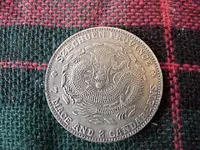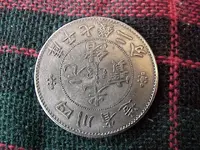China only began producing mass circulation silver coins in 1889 when the first modern coining press was imported into the country. As circulated coins until then had largely been the Mexican Silver Dollar, the new coins were based on these, but with Chinese styling. The denomination used however was the then standard “Mace” and “Candareens” being units of silver and measurable by weight. Therefore the legitimacy of the coin as being real and worth the value was obtained by weighing and measuring it – these units are the archaic version of what would now be 27.4 grams, containing 0.7814 of an ounce of silver.
This type of cion is known as Kiang Nan Dollars. There were derivatives of these issued by other provincial governments at the time, however there are also many fakes of this type of coin, produced over the past decades. Some of these have also now become collector’s items, as in order to pass them off the silver content remains high – so they may be worth digging out at a local Chinese market. To ascertain the real thing however it will feel “heavy,” and if you intend to uncover a legitimate example accurate weighing scales would be required. Fakes are discernable by their price, from RMB3 each at the Panjiayuan market in Beijing, to about US$10-15 on eBay, whereas the real thing will cost several hundred dollars from a reputable dealer.
Don...
Source:
http://www.china-briefing.com/blog/2007/12/21/chinese-silver-dragon-coins.htm:






